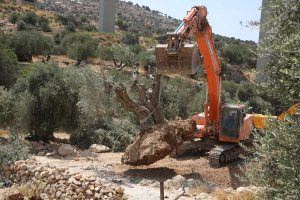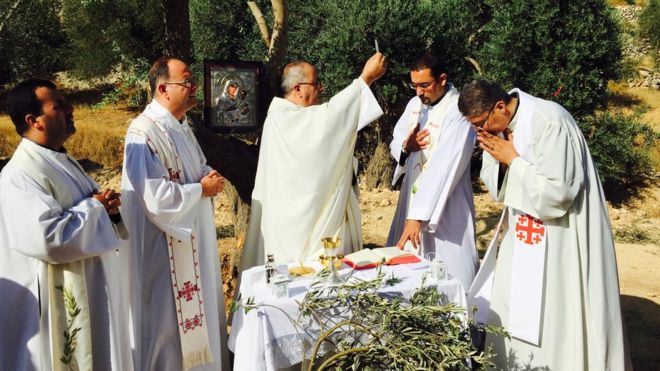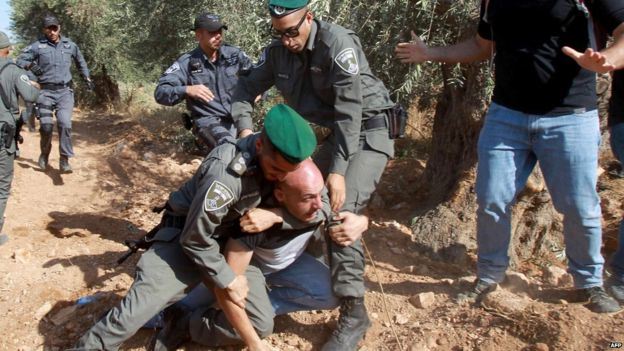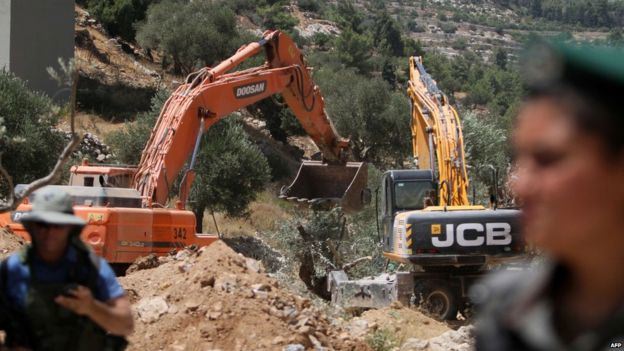Israeli bulldozers are back in Beit Jala in Occupied E. Jerusalem
 Wednesday, September 2, 2015 at 11:48PM
Wednesday, September 2, 2015 at 11:48PM http://benwhite.org.uk/2015/08/23/israeli-bulldozers-are-back-in-beit-jala/
by Ben White 23 August 2015 Middle East Monitor
 In 2004, I wrote an article about the story of Nabil Saba, a man from Beit Jala whose family was expelled in the early 1970s to make way for the Israeli settlement of Har Gilo. When I first spoke to him some 11 years ago, confiscation of land for the Apartheid Wall was well underway.
In 2004, I wrote an article about the story of Nabil Saba, a man from Beit Jala whose family was expelled in the early 1970s to make way for the Israeli settlement of Har Gilo. When I first spoke to him some 11 years ago, confiscation of land for the Apartheid Wall was well underway.
“The Wall has taken the land from the people of Beit Jala”, Nabil told me. “They have put us all in a prison. There is no land left for Beit Jala. We are in cantons, ghettoes, now.”
Visiting Beit Jala last week, this grim assessment is only confirmed. There is no more room. If people are building, they are building up; the price of land and property continues to rise, and the town, like so many other communities in Palestine, has no solution to apartheid’s tightening noose.
In the last few days, the bulldozers are back at work in Beit Jala, uprooting olive trees andpreparing the way for renewed construction of the Wall. Israeli occupation forces oversaw the removal of dozens of ancient trees and the levelling of land, while the Palestinian owners were kept away.
For nearly a decade, residents have tried to resist Israeli plans for the expropriation of their land and the construction of the Wall. The 2006 Israeli military order revealed that the Wall would include Har Gilo settlement on the ‘Israeli side’ and separate Beit Jala from the Cremisan Valley, where dozens of Palestinians own land, sandwiched between Israeli colonies.
The landowners’ legal action was joined by the Catholic monastery and convent located in Cremisan, supported by the Vatican. In April 2015, Israel’s Supreme Court, sitting as the High Court of Justice (HCJ), gave hope to the petitioners by demandingthat the occupation authorities “swiftly reconsider the various alternatives for the separation fence route in this section.”
Yet just weeks later, Israel’s Defense Ministry declared that it would continue construction of the Wall along the proposed route, with the exception of 200 metres next to the monastery and convent. Then in July, a bitter blow; the HCJ gave the green light for work on the Wall to go ahead.
The HCJ’s ruling was greeted with dismay by the Palestinians in Beit Jala. It was also condemned by the UK government and the European Union, with the latter expressing “deep regret and concern” at the court’s decision.
If built, this Barrier will severely restrict access of 58 families from their agricultural land and profoundly affect their livelihoods. It will also involve a further encroachment on Palestinian land close to Bethlehem, an area already severely affected by settlement expansion, thereby increasing pressure on the Palestinian population living there.
Stretching out across a hillside overlooking Bethlehem, the small town of Beit Jala has lost a considerable amount of its land over the years to Israeli colonisation; as of 2010, roughly 9 percent of its total area was taken up by settlements and Israeli military bases established over the years.
After 1967, a huge chunk of Beit Jala was expropriated as part of Israel’s illegal and unilateral expansion of Jerusalem’s municipal boundaries: Gilo settlement was subsequently constructed on these lands. In 1972, on the top of the hill, Har Gilo colony was established on land confiscated from the likes of Abu Jamal’s family; close to 1,000 settlers now live there.
Under the Oslo Accords, almost two-thirds of Beit Jala’s land was classified as Area C, where Palestinian construction is severely limited or impossible due to the discriminatory restrictions imposed by the Israeli military regime. Along with the Wall, the town is now choking under Israeli apartheid, unable to naturally expand.
Beit Jala’s story is a familiar one. Some 210,000 Palestinians live in the Bethlehem governorate, in addition to more than 100,000 Israeli settlers in 19 illegal colonies and outposts. More than 85 percent of the region is designated as Area C, and, according to the UN, less than 1 percent of this area “has an outline plan approved by the Israeli authorities allowing Palestinians to build legally.”
56 kilometres of the Apartheid Wall slices through the greater Bethlehem area, and it will ultimately separate 12 communities from the rest of the governorate. It is a microcosm of the Wall as a whole, whose route is twice the length of the 1967 ceasefire line (the ‘Green Line’), 85 percent of which lies inside the West Bank.
Justifying renewed construction of the Wall in Beit Jala, Israeli authorities cited the familiar security rationale. Even taking this argument at face value, the Wall is illegitimate; as the International Court of Justice stated in its advisory opinion, the Wall impedes “the exercise by the Palestinian people of its right to self-determination” and threatens to establish “de facto annexation.”
Yet the security rationale – cited in court by Israel’s Ministry of Defense, and repeated abroad by the country’s lobbyists – is deeply flawed. The route of the Wall and public statements by Israeli officials make it clear that the Wall has always been about colonisation and demographics. The bulldozers working once again in Beit Jala are a reminder of this reality, and of Israel’s ongoing impunity.
Published first by Middle East Monitor.
---------------------------------------------------------------------------------------------------------------------------------
Palestinian Christians urge help against West Bank barrier
By Yolande Knell
BBC News, Beit Jala
21 August 2015
http://www.bbc.co.uk/news/world-middle-east-34020724 The open-air mass was held to highlight opposition to the barrier
The open-air mass was held to highlight opposition to the barrier
Palestinian Christians are appealing for international support to oppose renewed construction of part of Israel's West Bank barrier.
Residents of Beit Jala - a town along the planned barrier route - made the appeal at an open-air mass among centuries-old olive trees on Friday.
They have also been waging a long legal battle, backed by the Vatican.
The barrier will separate over 50 families from their land - but Israel says it is a vital security measure.
An earlier attempt to pray at the site of Friday's mass had resulted in scuffles between Israeli border police and worshippers and priests.
At the start of the week, Israel's defence ministry began to prepare an area at the entrance to the Cremisan Valley for an expansion of the barrier.
Locals protested as some of the trees were removed by bulldozers and others were cut down.
 Palestinian protesters have clashed with Israeli forces in the Cremisan valley
Palestinian protesters have clashed with Israeli forces in the Cremisan valley
The mayor of Beit Jala has written to diplomats from the European Union and the United States, asking them to put political pressure on Israel not to continue.
"We want people outside to come and say 'enough is enough'," says the mayor, Nicola Khamis. "Christians all over the world must stop being silent."
"What Israel is doing here is against peace. It will prevent a two-state solution [to the conflict]."
Last year, Pope Francis met residents who stand to lose access to their land in the Cremisan Valley, when he visited nearby Bethlehem.
Foreign dignitaries have also expressed their concerns to Israeli authorities, listing the separation barrier among pressures that are pushing Christians to leave the Holy Land.
Israel says the barrier is needed in the valley as a security measure to protect the Jewish settlements of Gilo and Har Gilo. (see map)

Settlements are considered illegal under international law, although Israel disagrees.(typical BBC comment for balance, when they know full well it is unequivocally illegal! Ed)
 Bulldozers have been used to remove olive trees along the barrier route
Bulldozers have been used to remove olive trees along the barrier route
Construction of the Israeli barrier began in 2002, during the second Palestinian intifada or uprising, after a series of suicide attacks.
In the Beit Jala area, at this time, there was shooting at the settlements.
Palestinians believe the ultimate aim of the barrier - which includes stretches of high concrete walls and barbed-wire fences - is to grab land.
Much of it has been built inside the occupied West Bank on land Palestinians want for a future independent state.
In April, Israel's High Court appeared to rule against proposed routes for the barrier in the Cremisan Valley, a local beauty spot filled with olive groves and orchards.
However, the court later said this prevented work only in a small area near a Salesian convent and school, and a monastery and winery.
Local church leaders - Latin Catholic and Greek Orthodox - have been involved in the campaign to prevent the construction of the barrier.
"When you kill the olive trees, you kill the people here," said the Catholic priest, Faisal Hijazin, during the mass. "We pray for God to protect the olive trees, the land and the people."
 APJP |
APJP |  Post a Comment |
Post a Comment |
Reader Comments